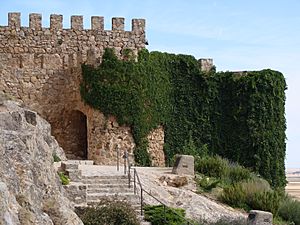Battle of Consuegra facts for kids
Quick facts for kids Battle of Consuegra |
|||||||
|---|---|---|---|---|---|---|---|
 Castle of La Muela in Consuegra. |
|||||||
|
|||||||
| Belligerents | |||||||
| Commanders and leaders | |||||||
| Strength | |||||||
| 10,000–20,000 | 30,000–35,000 | ||||||
| Casualties and losses | |||||||
| Unknown | Unknown | ||||||
The Battle of Consuegra was an important fight that happened on August 15, 1097. It took place near a village called Consuegra in Castile-La Mancha, Spain. This battle was part of a long period in Spanish history known as the Reconquista. During the Reconquista, Christian kingdoms in Spain tried to take back land from Muslim rulers.
In this battle, the Christian armies of King Alfonso VI from the Kingdom of Castile and León fought against the Almoravids. The Almoravids were a powerful Muslim group from North Africa. Sadly, the battle ended in a victory for the Almoravids. A famous person who died in this battle was Diego Rodríguez, the son of the legendary Spanish hero, El Cid.
Contents
What Was the Reconquista?
The Reconquista was a very long period in the history of the Iberian Peninsula (modern-day Spain and Portugal). It lasted for almost 800 years, from the 8th century to the 15th century. During this time, Christian kingdoms in the north slowly expanded their control. They fought to reclaim lands that had been conquered by Muslim armies centuries before.
This period was not just about fighting. It also involved times of peace, trade, and cultural exchange. Different groups learned from each other, even while they were often at war. The Battle of Consuegra was one of many important events during this long historical process.
Who Fought in the Battle?
The main leaders in the Battle of Consuegra were King Alfonso VI and Yusuf ibn Tashfin.
King Alfonso VI
Alfonso VI of León and Castile was a powerful Christian king. He ruled both the Kingdom of León and the Kingdom of Castile. He was a key figure in the Reconquista. King Alfonso wanted to expand his Christian kingdoms further south. He had a large army made up of soldiers from his different territories.
The Almoravids
The Almoravids were a strong Muslim empire. They came from North Africa and had taken control of parts of southern Spain. Their leader was Yusuf ibn Tashfin. The Almoravids were known for their disciplined and fierce warriors. They aimed to stop the Christian advance and protect Muslim lands in Spain.
Other Important People
Several other important commanders fought alongside King Alfonso VI. These included Álvar Fáñez, Pedro Ansúrez, and García Ordóñez. On the Almoravid side, Muhammad ibn al-Hajj was a significant leader.
The Battle Unfolds
The battle took place on August 15, 1097, near the town of Consuegra. King Alfonso VI's army was quite large, with an estimated 30,000 to 35,000 soldiers. The Almoravid forces were smaller, around 10,000 to 20,000 fighters.
The fighting was intense and fierce. The Almoravid cavalry (soldiers on horseback) were very effective. They managed to break through the Christian lines. The battle quickly turned in favor of the Almoravids.
A Sad Loss
During the battle, many Christian soldiers were killed. One of the most notable losses was Diego Rodríguez. He was the only son of the famous knight, El Cid. His death was a big blow to the Christian forces and to El Cid himself.
Aftermath of the Battle
After their defeat, King Alfonso VI and some of his remaining soldiers retreated. They found safety inside the Castle of La Muela in Consuegra. The Almoravid army then surrounded the castle. They laid siege to it for eight days.
A siege means the attacking army tries to cut off supplies and force those inside to surrender. However, after eight days, the Almoravids decided to withdraw. They moved back south, possibly because they had achieved their main goal or faced their own supply issues.
Impact of Consuegra
The Battle of Consuegra was a significant victory for the Almoravids. It showed their strength and temporarily halted the Christian advance. For the Christian kingdoms, it was a tough defeat. It reminded them of the challenges they faced in the Reconquista. Despite this loss, the Christian kingdoms continued their efforts in the long struggle to reclaim the Iberian Peninsula.
See also
 In Spanish: Batalla de Consuegra para niños
In Spanish: Batalla de Consuegra para niños

